
H. P. Lovecraft in Providence
H. P. Lovecraft's Life in Providence
H. P. Lovecraft
was born, lived most of his life, and died in Providence.
He lived for almost two years in Brooklyn,
but other than that, Providence was his home.
"I am Providence" is on his tombstone,
taken from a letter he wrote soon after returning from his
brief time in New York City.
This map shows a possible path you could follow through
Providence to see these sites in a geographical,
but not temporal, order.
All except the hospital and the observatory
are on or close to two streets,
Angell Street and
Prospect Street.
Let's get this out of the way to start with:
Howard Phillips Lovecraft was a horrible person.
He wrote some interesting short stories and novellas and short novels, all in the genres of "weird fiction" and "cosmic horror".
However, he was terribly racist and should, on a personal level, be dumped in the garbage along with the Ku Klux Klan, the neo-Confederates, and others that Republican leader Donald Trump has repeatedly described as "very fine people". Along with Trump and his supporters.
But, to make an effort to consider just Lovecraft's creative side and his personal history in Providence...
454 Angell Street
H. P. Lovecraft was born in a three-story mansion at 454 Angell Street in Providence. It was on a large lot at the corner of Angell and Elmgrove. The house was torn down in 1961 and replaced by a very mundane three-story apartment building. The street number has been reassigned to a nearby house built in what would have been the back corner of the large lot of Lovecraft's time.
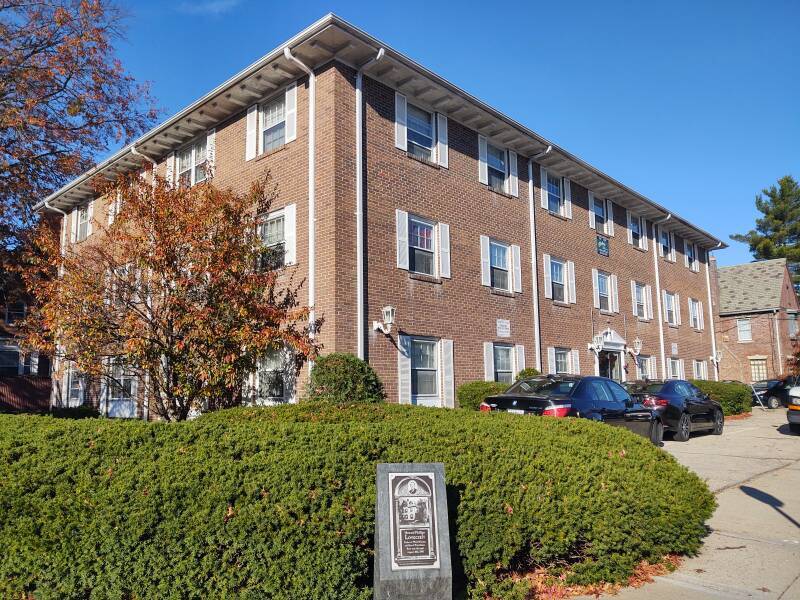
In one of his many letters he wrote:
I was born on the 20th of August, 1890, at No. 454 (then numbered 194) Angell Street, in the city of Providence. This was the home of my mother's family; my parents' actual residence at the time being in Dorchester, Mass. [...] In the mid-seventies, muy grandfather transferred all his interests to Providence (where his offices had always been & erected one of the handsomest residences in the city—to me, the handsomest—my own beloved birthplace! This spacious house, raised on a high green terrace, looks down upon grounds where are almost a park, with winding walks, arbours, trees, & a delightful fountain.
The family lived in that house from 1893 through 1904, when his grandfather, Whipple Phillips, died. The marker shows a picture of the house.
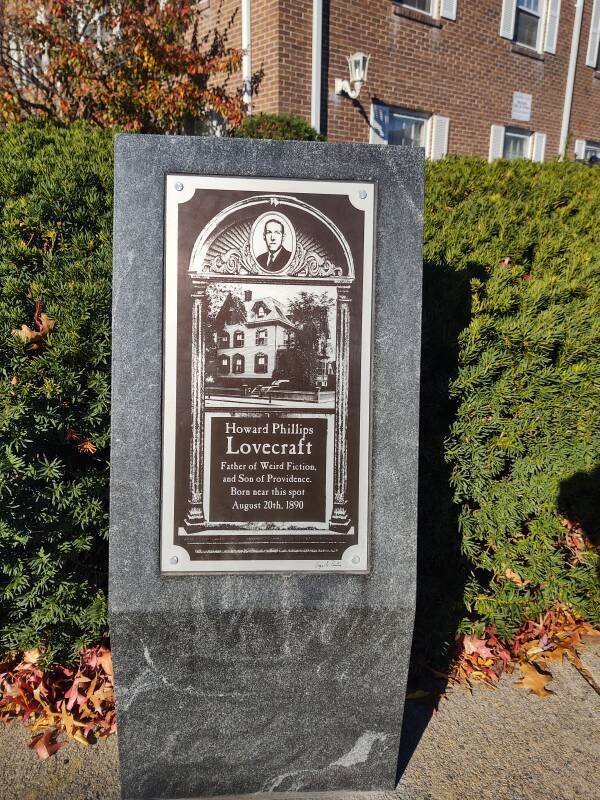
There is a bookstore across the street and a coffeeshop nearby, both of which would probably please Lovecraft. As I had learned earlier, Providence has the most coffee shops per capita of any city in the U.S.
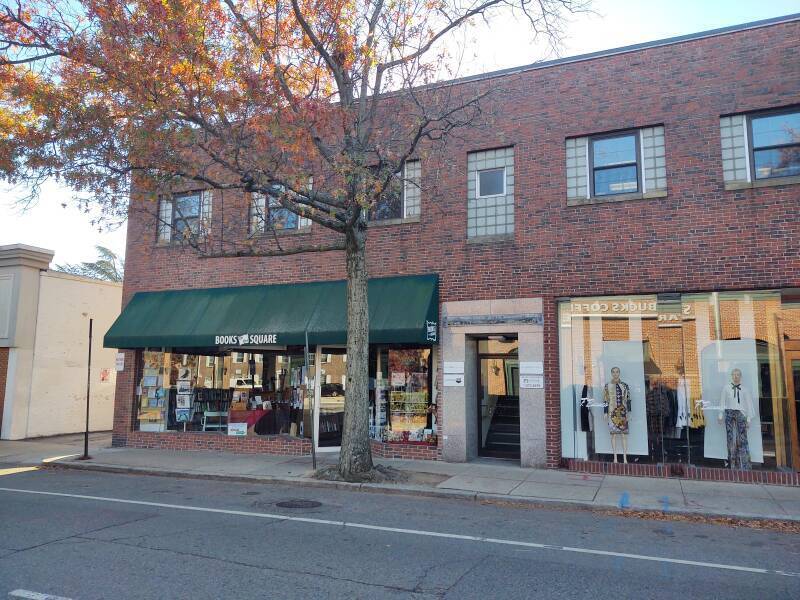
Butler Hospital
H. P. Lovecraft's father, Winfield Scott Lovecraft, traveled a great deal for business. He suffered some sort of psychotic episode in a hotel in Chicago in April 1893, when Howard was not quite three years old. He was committed to Butler Hospital along the Seekonk River in eastern Providence, about 2.5 kilometers from the family home. The medical records state that he had been "doing and saying strange things at times" for a year before he was committed.
He died five years later, in 1898. His death certificate described the cause as "general paresis", a term used at that time along with "general paralysis of the insane" or GPI, "paralytic dementia", and "syphilitic paresis", all of those indicating a neuropsychiatric disorder caused by late-stage syphilis without necessarily saying exactly that.
The connection with syphilis was discovered in the late 1880s. Until drugs and other treatments were discovered in the 1910s through the 1940s, GPI accounted for up to 25% of the primary diagnoses of residents in public psychiatric hospitals.
Until then, the prognosis was for death probably within three to five years, as was the case for Winfield Lovecraft.
The Austrian physician Julius Wagner-Jauregg discovered in 1917 that malaria therapy, medical induction of a fever, could halt the progression of general paresis. In 1927 he was awarded the Nobel Prize for that discovery. After World War II, the use of penicillin rendered GPI a rarity. It now seldom occurs in developed countries.
H. P. Lovecraft always maintained that his father had fallen into a paralytic state because of insomnia and overwork. It has never really been known if he had been kept ignorant of the details of his father's condition, or if he had known the truth but deliberately said that to obscure the truth.
There is a short cut to the medical complex off Grotto Avenue where Brookway Road tees in, rather than following Blackstone Boulevard all the way north to the main entrance and then looping back.
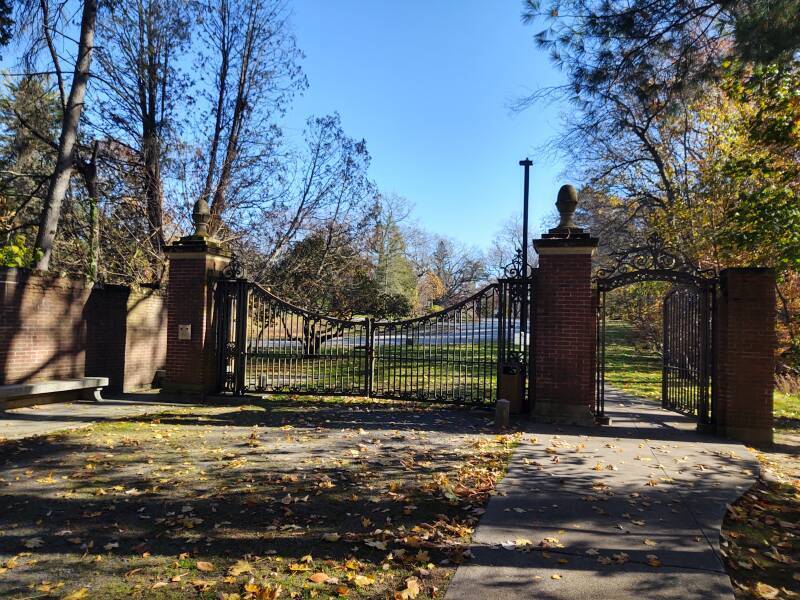
The hospital opened in 1847.
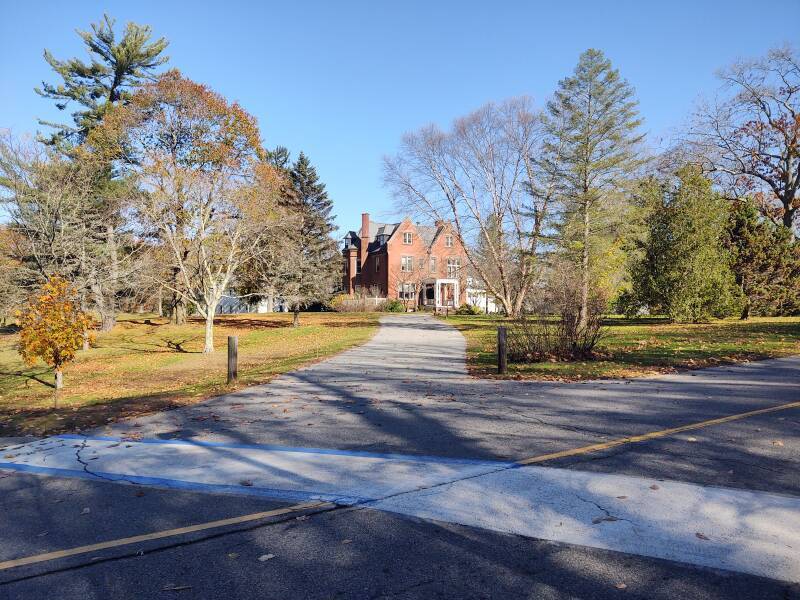
Howard's mother had a nervous collapse in early 1919 and was admitted into the hospital on 13 March. She died there on 24 May 1921 after a gall bladder operation that did not go well.

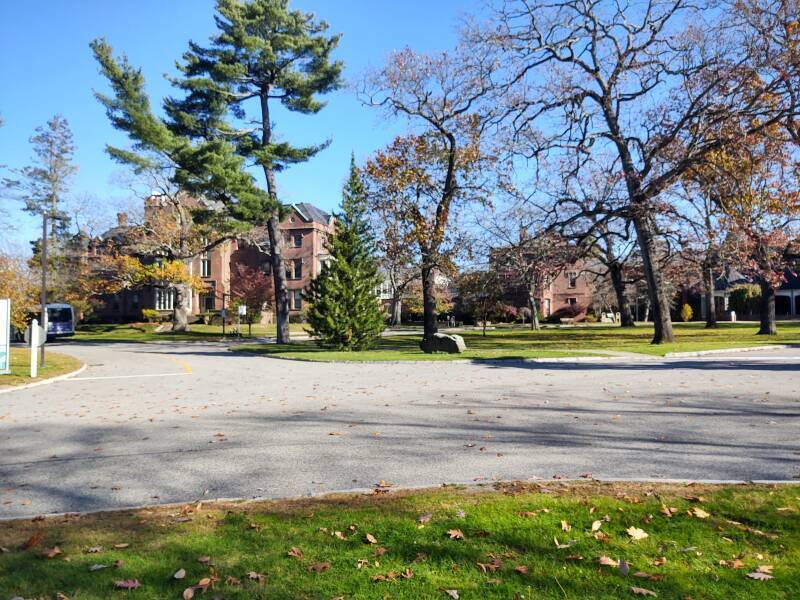
598 Angell Street
Lovecraft wrote in 1915:
In 1904 the death of my beloved maternal grandfather broke up the home at 454 Angell St., and caused my mother and myself to take our present smaller quarters at No. 598 on the same thoroughfare.
Here is 598 Angell Street, to which Lovecraft, his mother, and two aunts moved in 1904. He lived here until 1924.
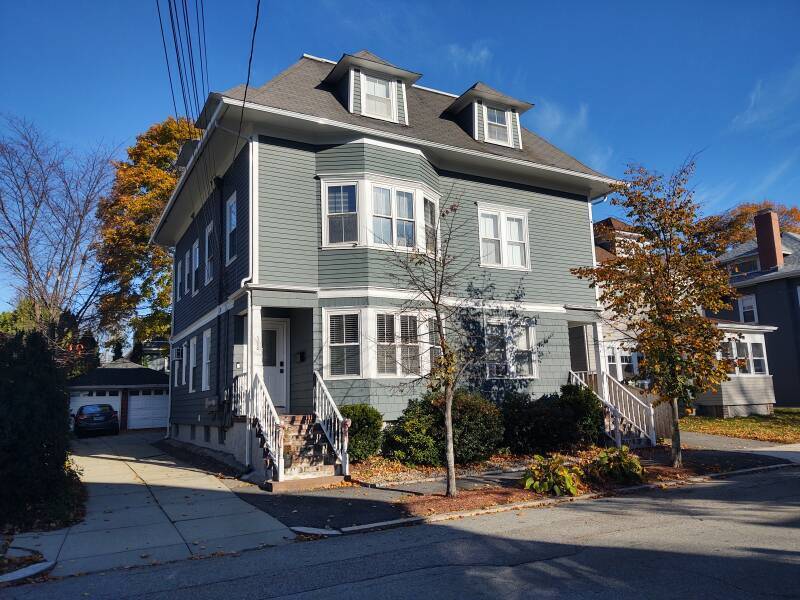
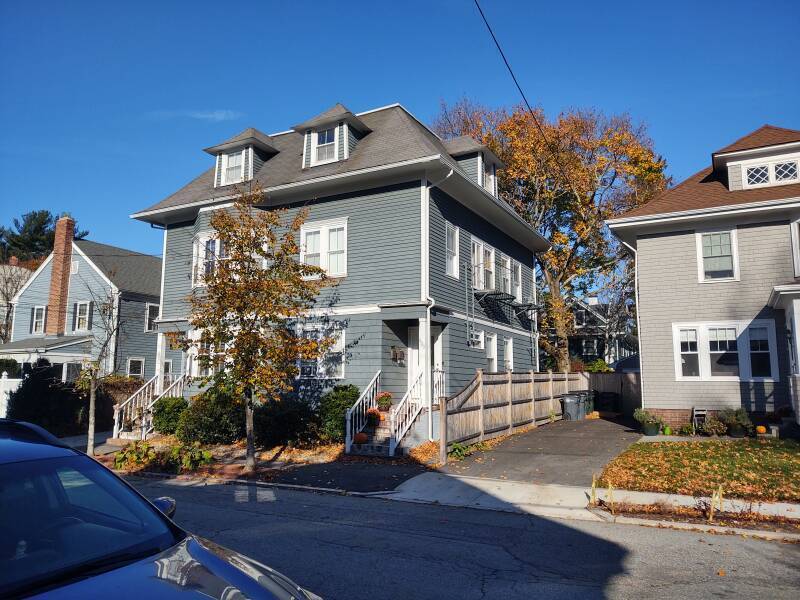
Ladd Observatory
The Ladd Observatory is about a kilometer north of the Brown campus. Lovecraft wrote in a 1916 letter:
The late Prof. Upton of Brown, a friend of the family, gave me the freedom of the college observatory, & I came & went there at will on my bicycle. Ladd Observatory tops a considerable eminence about a mile from the house. I used to walk up Doyle Avenue with my wheel, but when returning would have a glorious coast down it.
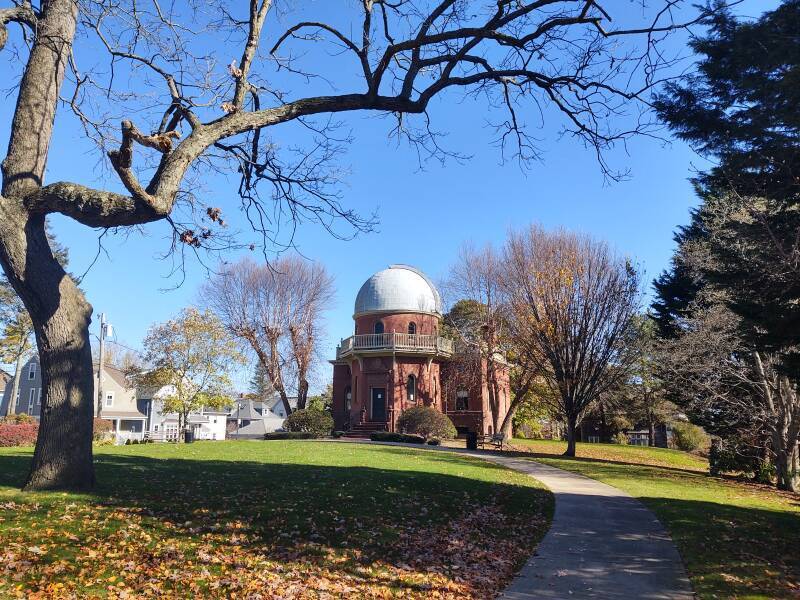
The observatory was fairly new then, having been given to the university in 1891. Its primary telescope is a 12-inch refractor.
The observatory became the local time reference in 1893. Astronomers observed star transits, when certain stars passed through the meridian, the north-south line overhead, and thereby calculated the precise local time. They sent time signals over telegraph wires to the Brown University campus and local utilities and businesses.
In 1916 the local clocks began to be calibrated by radio signals from NAA, the U.S. Naval Observatory transmitter in Arlington, Virginia. But in April 1917 the U.S. Government ordered that all radio sets must be dismantled due to the U.S. entry into World War I, and the observatory returned to time service. In October 1919, almost a year after the end of the war, radio reception had become legal again. The Providence fire department continued using the Ladd Observatory time signals until 1955, and some businesses used them even later. In 1973 the observatory determined that no businesses were using their time signals, and they stopped the program.
Lovecraft was fascinated by astronomy and interested in other fields of science. But that didn't stop him from suggesting that science might some day tell us more than we can handle.
The most merciful thing in the world, I think, is the inability of the human mind to correlate all its contents. We live on a placid island of ignorance in the midst of black seas of infinity, and it was not meant that we should voyage far. The sciences, each straining in its own direction, have hitherto harmed us little; but some day the piecing together of dissociated knowledge will open up such terrifying vistas of reality, and of our frightful position therein, that we shall either go made from the revelation or flee from the light into the peace and safety of a new dark age.
— "The Call of Cthulhu", 1926, published in Weird Tales, February 1928.
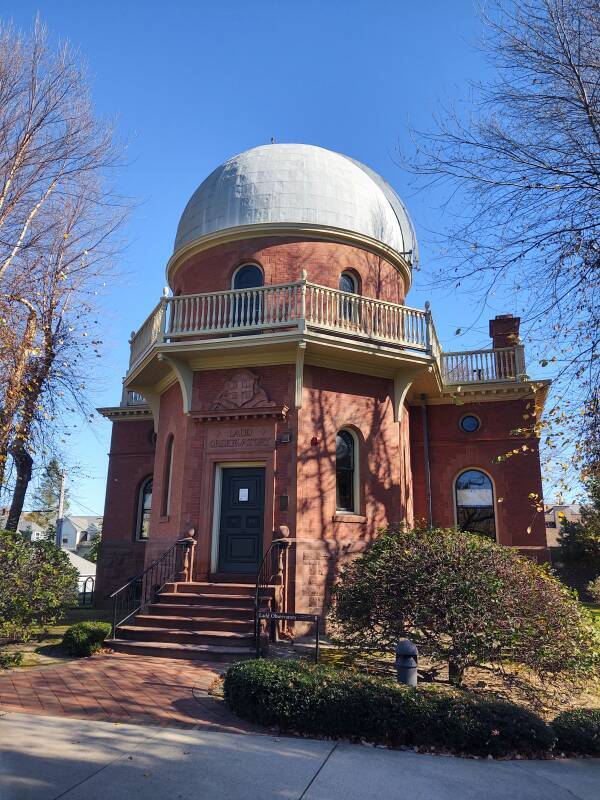
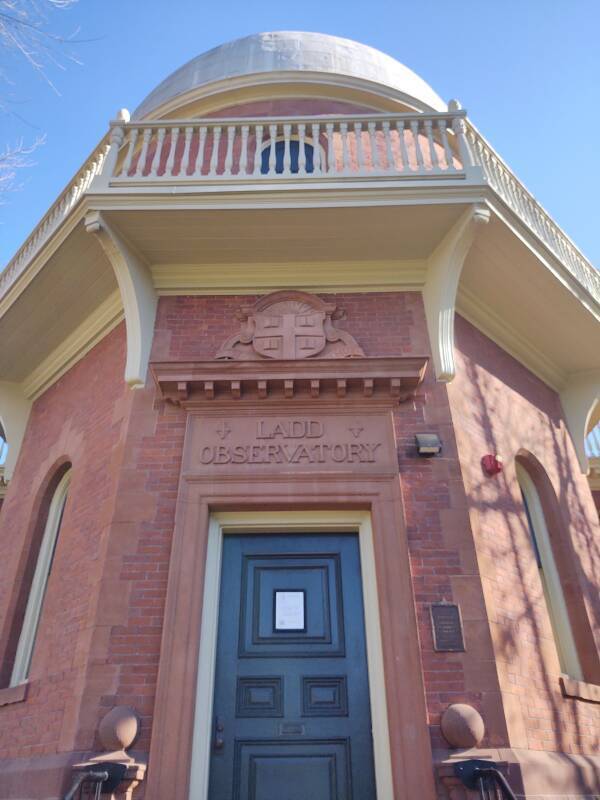
Science, already oppressive with its shocking revelations, will perhaps be the ultimate exterminator of our human species—if separate species we be—for its reserve of unguessed horrors could never be borne by mortal brains if loosed upon the world.
— "Facts Concerning the Late Arthur Jermyn and His Family", 1920, published in Weird Tales, April 1924.
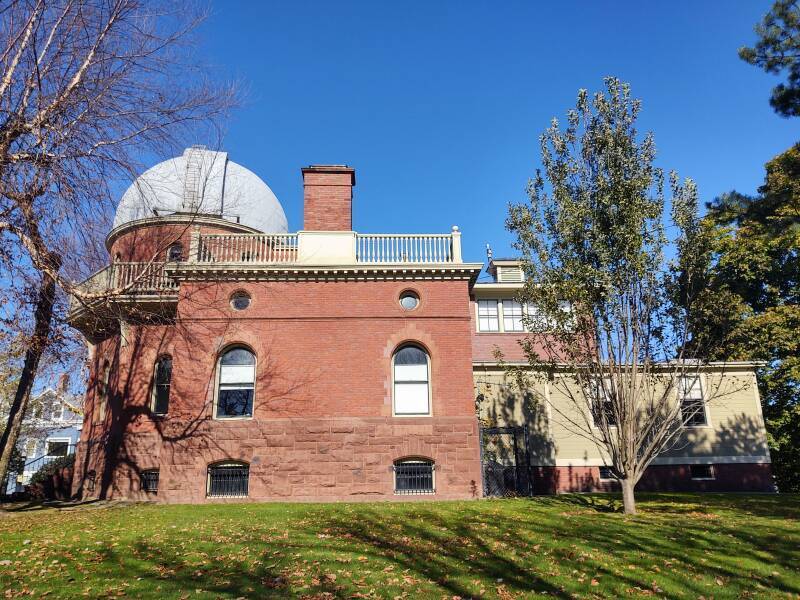
New York City, Briefly
H. P. Lovecraftin New York City
Lovecraft met Sonia Green through the amateur press community. She was seven years older than him, a divorcée, and with a Ukrainian Jewish background. She was a department store executive in New York City.
Lovecraft began visiting her in New York in 1922. They married in 1924 and he moved into her apartment in Brooklyn. He lived in New York until 1926.
She had moved to Cleveland for work in 1925, and he moved into a much smaller apartment. His aunt paid for the rent there. He wrote "The Horror at Red Hook" and "He" during this time, clearly displaying his fear and dislike of the immigrant crowds of Brooklyn. See another page of mine for pictures of the apartments and other places associated with him in New York.
He moved back to Providence in April 1926. He and Sonia agreed to an amicable divorce a few years after his return, although he never got around to signing and filing the final paperwork.
10 Barnes Street
Lovecraft moved into 10 Barnes Street on his return to Providence. He lived here from 1926 to 1933, and this was his most productive period. Here we're looking east down Barnes Street toward his home, the fourth house down the north or left side from Prospect Street.
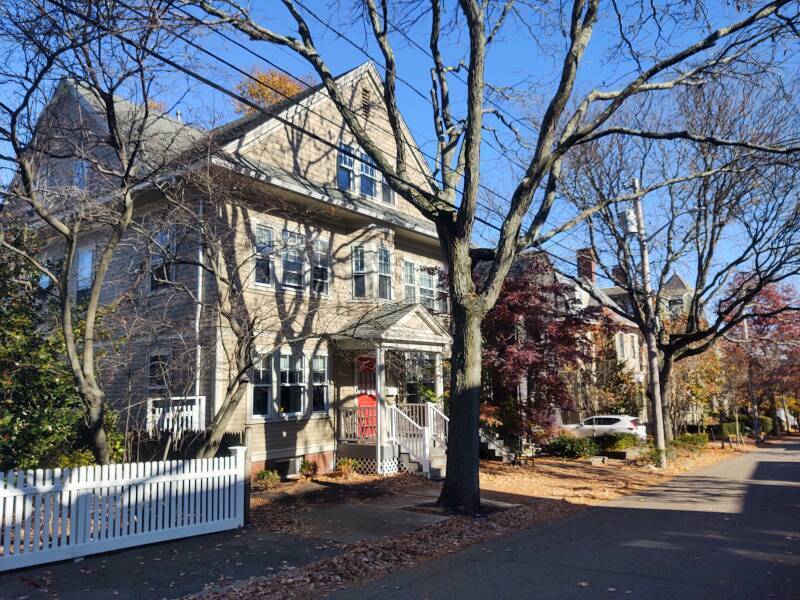
Here is #10. It still is divided into several apartments.
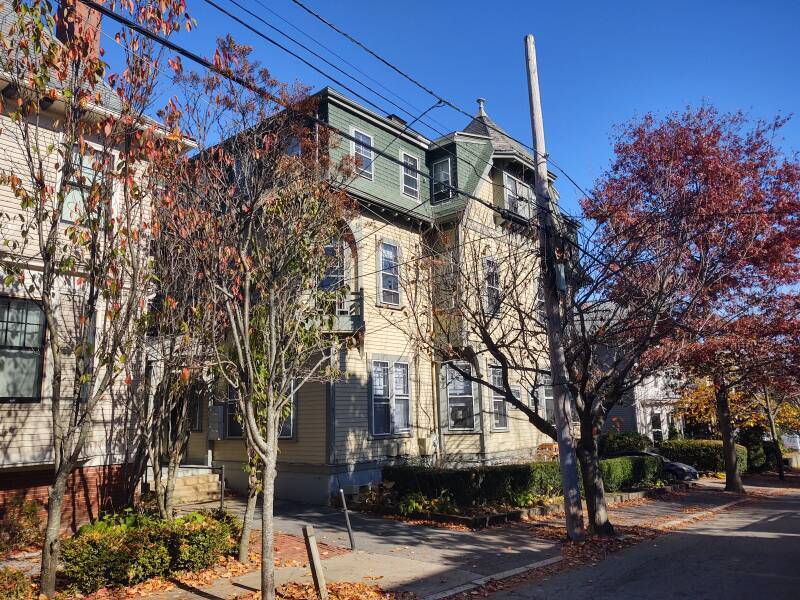
Lovecraft had a ground-floor one-room apartment here.
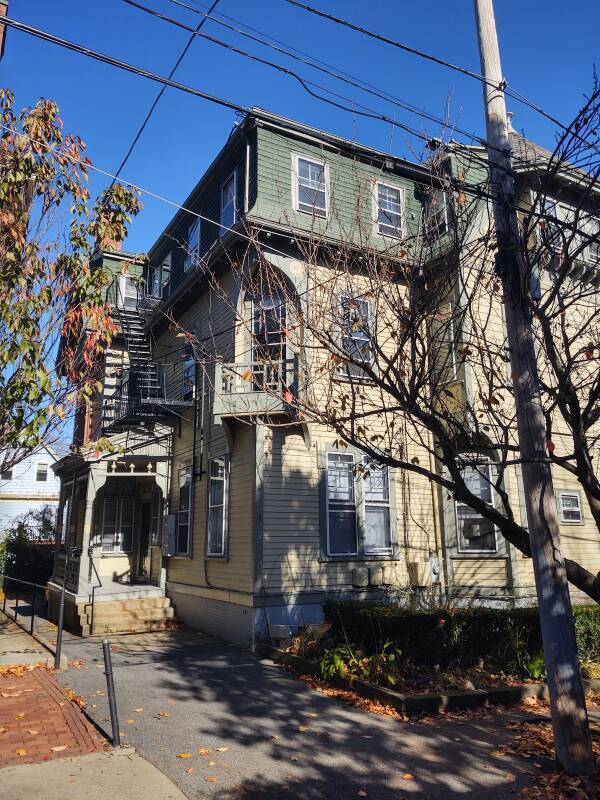
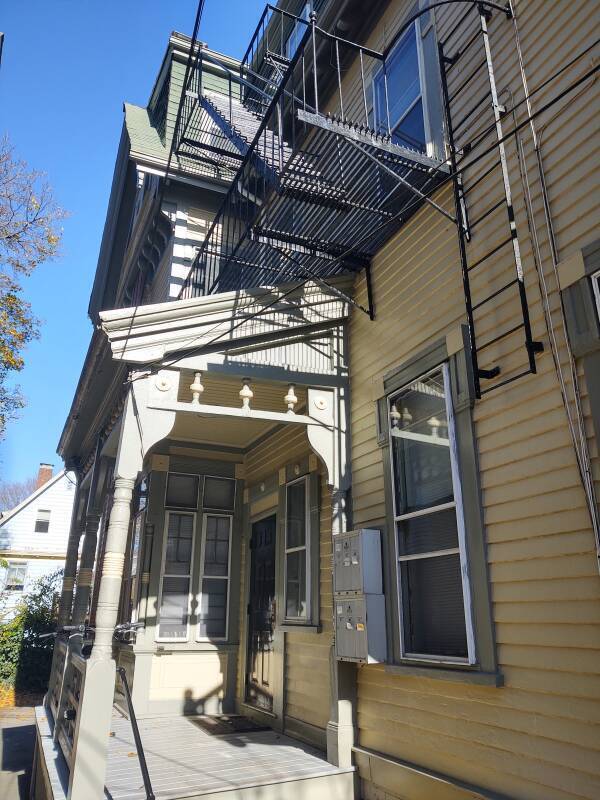
The door on the west side, the left side looking at the house from the street, has six mailboxes for apartments entered from that side.
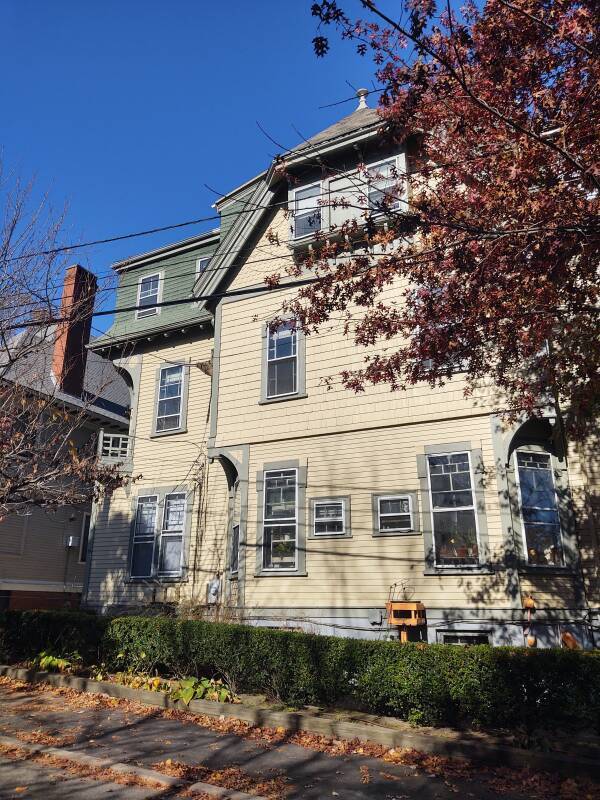
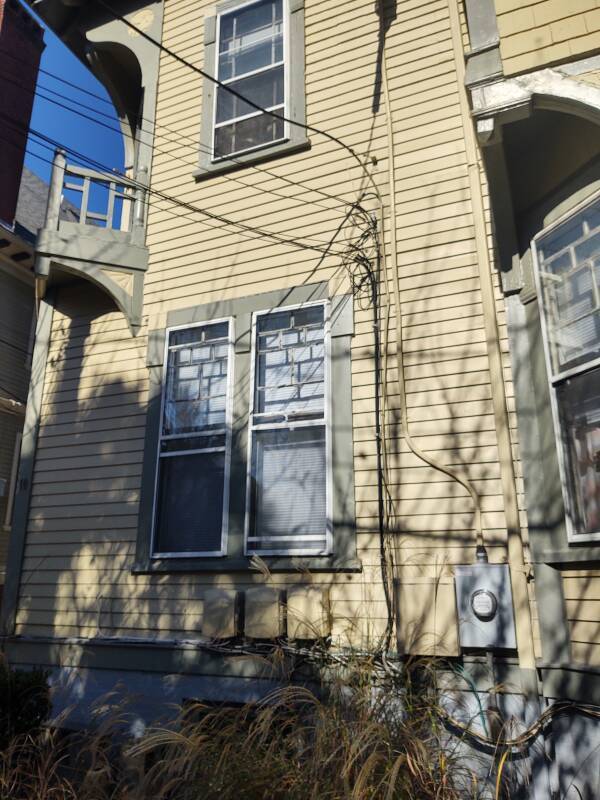
The street side has several voice and data line drops.
The door on the east side, the right as seen from the street, has mailboxes for another six apartments.
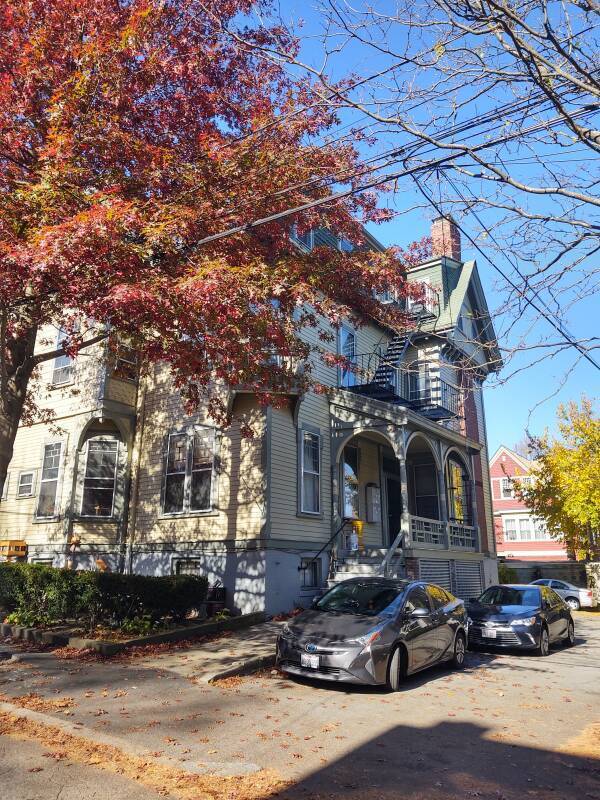
He wrote of it in a letter to Frank Belknap Long in April 1926, within a month of moving in.
As for the place—I have a fine large ground-floor room (a former dining room with fireplace) and kitchenette alcove in a spacious brown Victorian wooden house of the 1880 period—a house, curiously enough, built by some friends of my own family, now long dead.
Prospect Terrace
The park and overlook at Prospect Terrace is a short distance away from 10 Barnes Street. Looking up at it from Pratt Street in the late afternoon, you see the statue of Roger Williams looking into the sunset.

From the park in the late morning there's a nice view over the downtown area.
After the disappointing attempt at finding his grave, described on an earlier page, the people of Providence gathered up the teeth and presumed human bone fragments and buried them in the structure on which the statue stands. It is inscribed "Here reposes dust from the grave of Roger Williams".
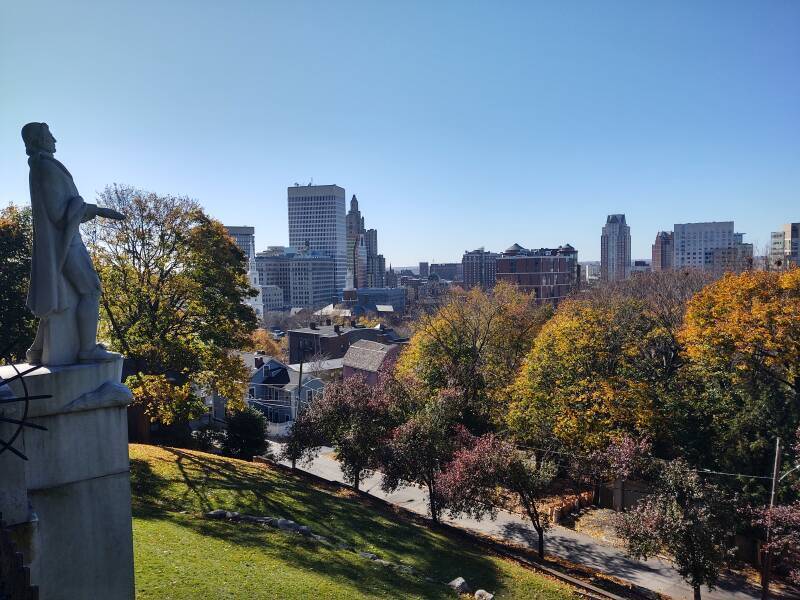
The park was one of Lovecraft's favorite places, and he included it in fictional works.
The nurse used to stop and sit on the benches of Prospect Terrace to chat with policemen; and one of the child's first memories was of the great westward sea of hazy roofs and domes and steeples and far hills which he saw one winter afternoon from that great railed embankment, all violet and mystic against a fevered, apocalyptic sunset of reds and golds and purples and curious greens. The vast marble dome of the State House stood out in massive silhouette, its crowning statue haloed fantastically by a break in one of the tinted stratus clouds that barred the flaming sky.
— "The Case of Charles Dexter Ward", 1927, published in Weird Tales in May and July 1941.
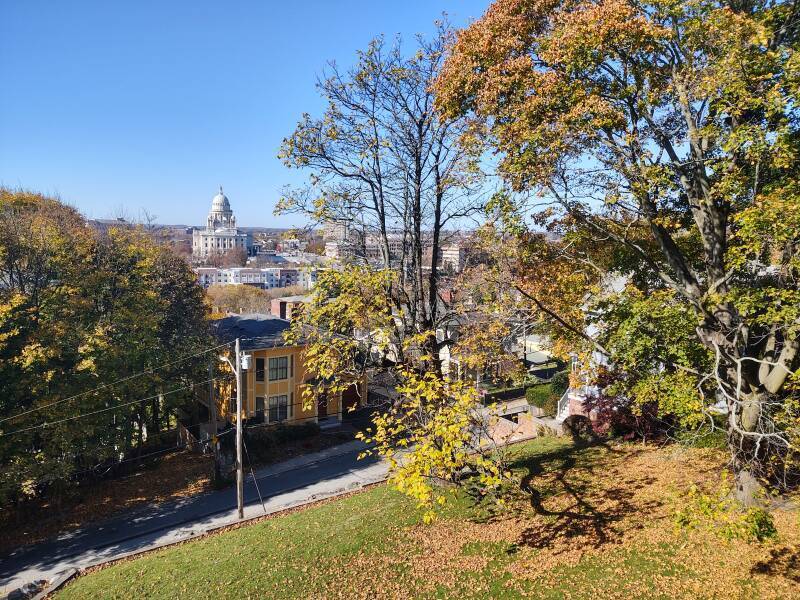
66 College Street
Lovecraft's final home was at 66 College Street, right behind Brown University's John Hay Library. He told friends in letters of his frequent visits to special exhibitions of books and other items.
He had moved into an apartment in the house in 1933 with his elderly aunt Annie Gamwell, so the two could pool their meager resources.
The house was moved when Brown expanded. The Bell Gallery now stands in its former location.
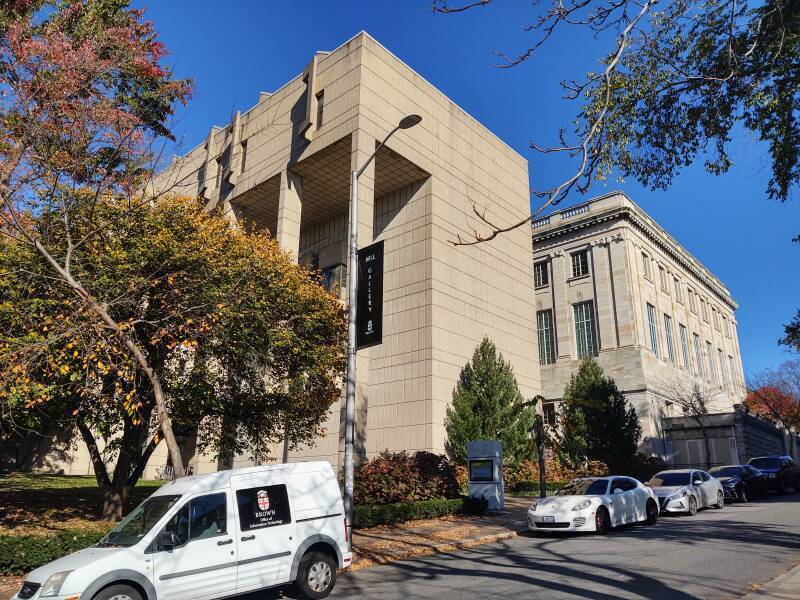
Lovecraft described the original location, the house, and his own room and writing desk as the setting in a story:
Young Blake returned to Providence in the winter of 1934–5, taking the upper floor of a venerable dwelling in a grassy court off College Street—on the crest of the great eastward hill near the Brown University campus and behind the marble John Hay Library. It was a cozy and fascinating place, in a little garden oasis of village-like antiquity where huge, friendly cats sunned themselves atop a convenient shed. The square Georgian house had a monitor roof, classic doorway with fan carving, small-planed windows, and all the other earmarks of early Nineteenth Century workmanship. Inside were six-paneled doors, wide floor-boards, a curving colonial staircase, with Adam-period mantels, and a rear set of rooms three steps below the general level. Blake’s study, a large southwest chamber, overlooked the front garden on one side, while its west windows—before one of which he had his desk—faced off from the brow of the hill and commanded a splendid view of the lower town’s outspread roofs and of the mystical sunsets that flamed behind them.
— "The Haunter of the Dark", 1935, published in Weird Tales, December 1936.
65 Prospect Street
The house was moved up the hill to the next corner at Prospect Street, and then north for five blocks to its new location at 65 Prospect Street.
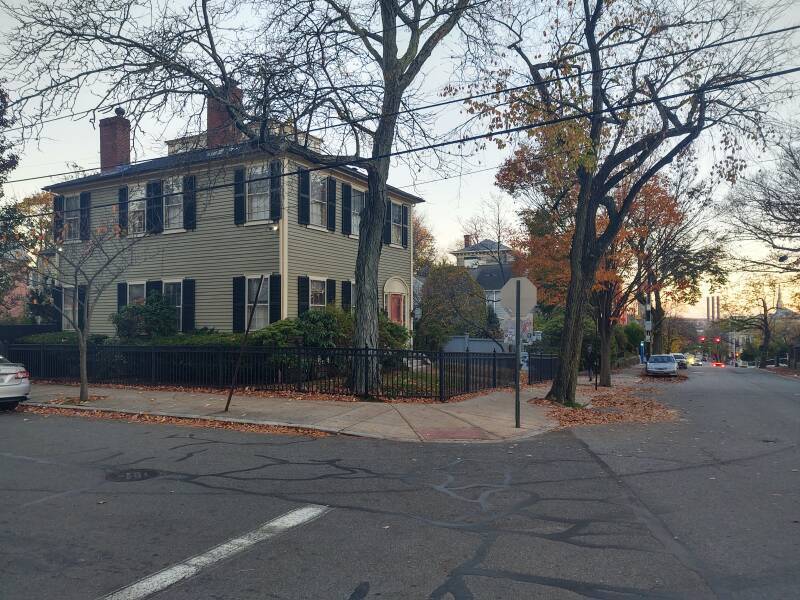
In its new location it has a historic marker as the "Samuel B. Mumford House" with no mention of HPL.
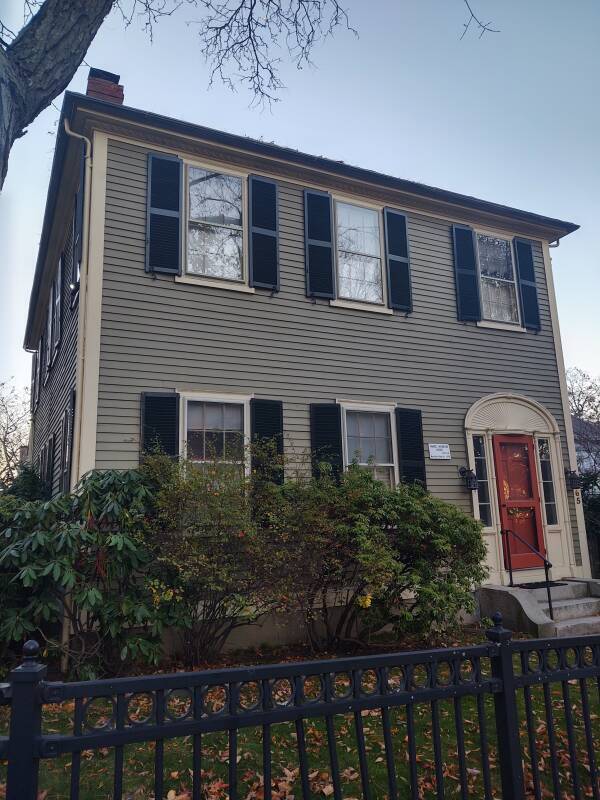
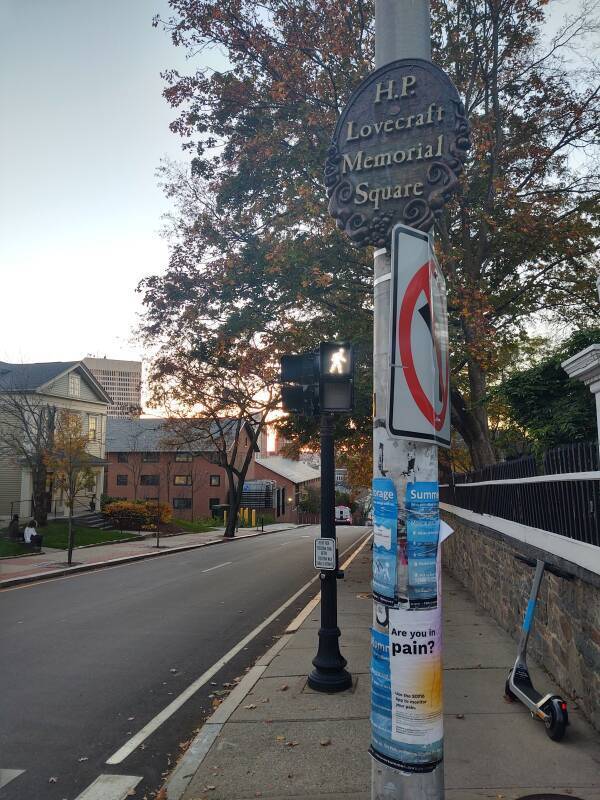
The intersection of Angell Street and Prospect Street has a sign at one corner marking it as "H. P. Lovecraft Memorial Square". It isn't a square, it's just an intersection with a stopsign at each corner.
Now on to the locations Lovecraft used in his fiction.